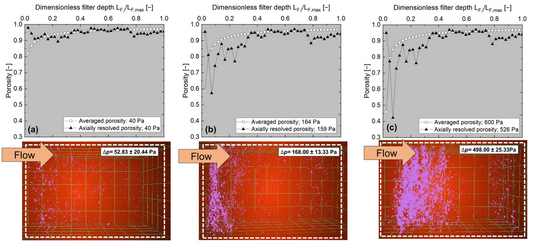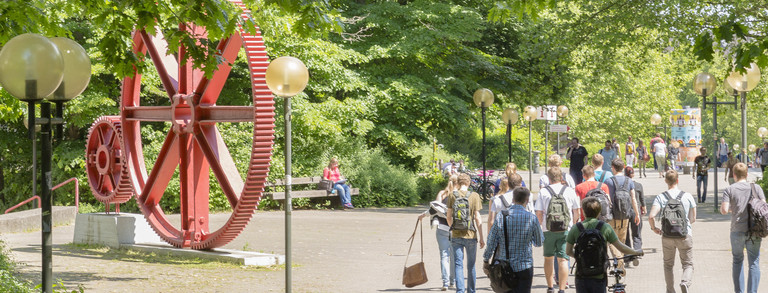Lukas Wischemann, M.Sc.
Contact
Telephone
(+49)231 755-3962
Address
Department of Biochemical and Chemical Engineering
Laboratory of Solids Process Engineering
Room G3-4.16
Emil-Figge-Str. 68
44227 Dortmund

Contents
Abstract
The modelling of particle separation in depth filters can often prove challenging due to multiple involved physical phenomena and complex filter microstructures. In order to provide reasonably accurate results based on real structural data, this project focusses on a one-dimensional model, axially discretizing the filter into increments. Experimentally generated tomographic images provide the structural data for each increment. This technique allows local structural optimizations of depth filters and the modelling of heterogeneous filter designs at a reduced computational effort.
Description
Depth filtration is a widely established method for the filtration of airborne particles [1]. As filters used for depth filtration cause increasing pressure differentials in process streams as they become loaded, there have been efforts to optimize porosity gradients and the design of the particle collectors to minimize energy consumption and extend service life. [2] However, the loading of the filter from already separated particles complicates such optimizations, since the filtration performance and pressure differential become time dependent and will vary, based on the structures formed by separated particles and particle collectors.
Simulations are often used to analyze depth filtration kinetics and optimize filter structures [2, 3]. For a more accurate modelling of depth filters, it is necessary to supply the simulations with realistic structural data. Information about local porosities in the filter medium and further structural data like orientations of particle collectors are obtainable from imaging technologies like computer tomography. The level of detail of the simulation increases with more accurate structural data and detailed descriptions of the physical phenomena involved in particle separation, as well as multidimensional computations, which leads to an increased demand in computational power and time.
The idea of this work is to develop a one-dimensional model [4] while still considering realistic structural data from tomographic images of the filter medium. This approach allows structural optimization by axially discretizing the filter. Each discrete element contains structural data from tomographic images, which also enables the simulation of heterogeneous filter materials. Additionally, tomographic images of filters loaded with suitable aerosols may provide further data to analyze particle depositions and serve as an experimental approach to verify the model. This project aims to provide tools for comparatively fast calculations with reasonable accuracy for developing and optimizing filters without the economic barriers to access and higher computational demands that multidimensional calculations have.

This project is made possible by the funding of the AiF (22824 N/FE 1) and
is a cooperation of the Laboratory of Solids Process Engineering (TU Dortmund) and the RIF (TU Dortmund).
References
[1] I. M. Hutten, Handbook of non-woven filter media, Elsevier [u.a.], Amsterdam [u.a.] 2007.
[2] K. Hoppe, F. Giesa, G. Schaldach, M. Thommes, D. Pieloth, Materials Today Communications 2024, 38, 108510. DOI: https://doi.org/10.1016/j.mtcomm.2024.108510
[3] G. Berry, I. Beckman, H. Cho, Journal of Aerosol Science 2023, 167, 106078. DOI: https://doi.org/10.1016/j.jaerosci.2022.106078
[4] K. Hoppe, L. Wischemann, G. Schaldach, R. Zielke, W. Tillmann, M. Thommes, D. Pieloth, Atmosphere 2023, 14 (4), 640. DOI: https://doi.org/10.3390/atmos14040640
Curriculum Vitae
| Since 2024 | PhD at the Laboratory of Solids Process Engineering, TU Dortmund |
| 2019 - 2024 | M. Sc. Chemical Engineering , TU Dortmund Master Thesis: Prediction of the Drug Degradation Kinetics in Amorphous Solid Dispersions |
| 2013 - 2019 | B. Sc. Chemical Engineering , TU Dortmund Bachelor Thesis: Investigation of Local and Time Dependency on the Particle Deposition in Depth Filters |
| Born | May 31st, Münster (Germany) |


